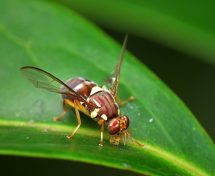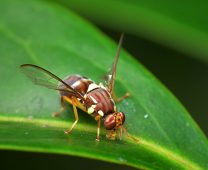Pesticides are an important tool for managing horticultural pests, but to be sustainable their use must be offset against their negative impacts. Researchers at Macquarie University's Applied BioSciences and Department of Molecular Sciences are tackling this challenge by working to develop novel pesticides which offer effective but softer options compared to their counterparts.

Queensland fruit fly. Image by Wikipedia Commons
A key challenge for pesticide use is the unintended or off target impact upon insects, animals, plants, growers, and consumers. In practice one method of managing this is by using an insect lure or bait and a pesticide in combination. While this offers a more targeted approach and reduces adverse activity such as blanket spraying it can still have safety or effectiveness issues.
In a study published recently in the Journal of Pest Science researcher Dr Soo Park investigated the derivatives of benzyl acetone. Benzyl acetone has a common structural feature with both cuelure and melolure, which are well-known non-toxic plant-based attractants of many pest species of fruit fly, including one of Australia's most significant horticultural pests the Queensland fruit fly (Qfly).

Queensland fruit fly. Image by Wikipedia Commons
Taking a lead from earlier work conducted with methyl eugenol, another plant based attractant, and oriental fruit flies, Dr Park theorized that incorporating the element fluorine with benzyl acetone may result in a compound which was both attractive to Qfly and toxic to them as well.
In an outdoor field cage experiment Dr Park assessed nine benzyl acetone compounds along with cuelure, and melolure to determine their attractiveness and toxicity to Qfly. Amazingly six of the compounds tested proved to be acute toxins and were as attractive to male Qfly as cuelure and melolure over the tested range.
Whilst further study will be needed to determine the mode of action and to better understand the pesticide properties, this range of new compounds may offer a class of pesticide which is attractive and toxic to fruit flies but with low toxicity to mammals. This is certainly a step forward in reducing off-target impact, limiting health risks and offering a more sustainable pesticide solution to one of Australia's most significant horticultural pests.






